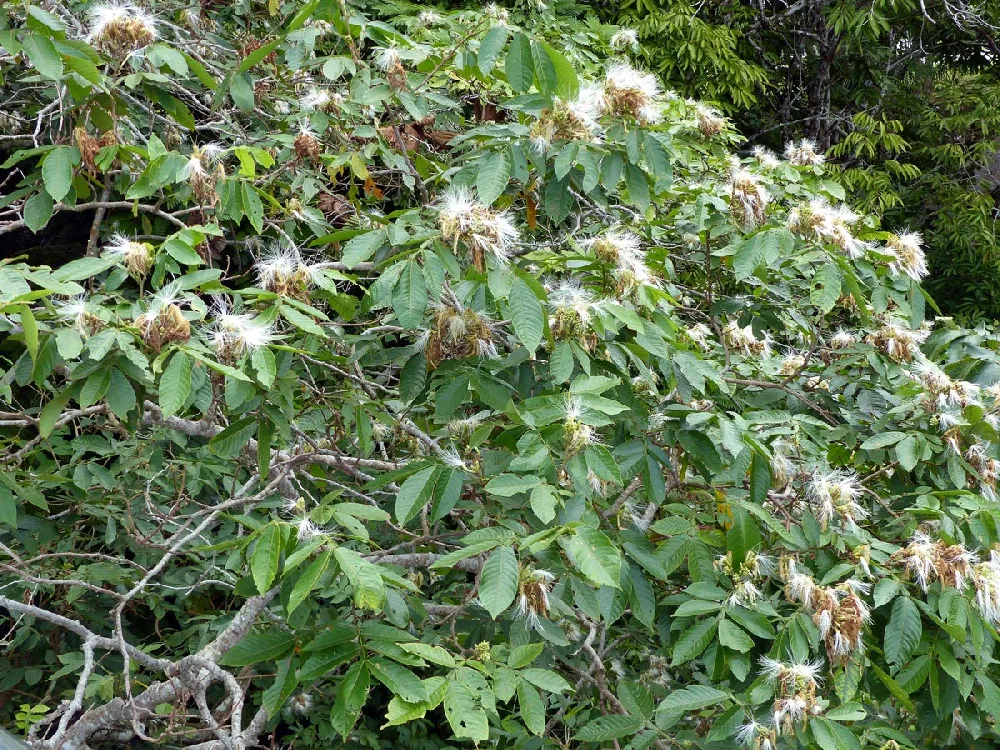
Ice Cream Bean Tree
Inga edulis
Basic Information
🌿 Family: Fabaceae🗺️ Zone: 9-11
Other Names:
- Guama
- Guaba
- Joaquiniquil
- Cuaniquil
🌡️ Ideal Temperature : 73°F – 86°F
🔥 Heat Tolerance: Up to 95°F
❄️ Cold Tolerance: Down to 28°F
🌱 Type: Perennial
Layers
- Canopy
Functions
- Edible
- Nitrogen Fixer
- Shade Provider
- Soil Improver
Pests
No pests associated with this plant.
Companions
- Coffee
- Cocoa
- Tea
Plants to Avoid
- None known
Description
The Ice Cream Bean Tree (Inga edulis) is a fast-growing, tropical leguminous tree native to South America. It can reach heights up to 30 meters (98 feet) with a trunk diameter of about 60 centimeters (2 feet). The tree features a pale gray trunk and a broad, moderately dense canopy formed by branches that often start below 3 meters (9.8 feet). Its leaves are pinnate, dark green, and slightly pubescent, with 4–6 pairs of oval leaflets. The tree produces fragrant, white, pentamerous flowers arranged in dense axillary spikes. The fruit is a cylindrical, indehiscent pod that can grow up to 1 meter (3.3 feet) long, containing numerous seeds embedded in a sweet, cottony, white pulp reminiscent of vanilla ice cream.
✂️🫘 Methods to Propagate:
Propagation is typically achieved through seeds, which are recalcitrant and often begin germinating while still in the pod. It's advisable to plant seeds promptly, as they lose viability within two weeks of storage. Direct sowing is possible, but raising seedlings to a certain height before planting can reduce competition from weeds and enhance growth. In nutrient-depleted soils, inoculating seedlings with rhizobia and mycorrhizal fungi can promote better establishment.
🌞💧 Sun and Water Requirements:
The Ice Cream Bean Tree thrives in full sun but can tolerate partial shade. It is adaptable to various soil conditions, including those that are temporarily waterlogged for 2–3 months annually, and can withstand drought periods of up to six months. The tree prefers well-draining soil with a pH between 5 and 6.5 but can tolerate a range from 4.5 to 8. Regular watering during establishment is essential, after which the tree becomes relatively drought-tolerant.
🧑🌾👩🌾 When to Harvest:
The fruiting period varies depending on the local climate. Generally, the pods are ready for harvest when they turn yellowish-brown to green and can be easily opened to reveal the sweet pulp. The fruit ripens quickly and should be consumed within 3–4 days, although refrigeration can extend its shelf life to about three weeks.
Purpose
- **Edible:** The sweet, cottony pulp surrounding the seeds is consumed raw and has a flavor reminiscent of vanilla ice cream. The seeds, once cooked, are also edible and comparable in taste to chickpeas.
- **Nitrogen Fixer:** As a leguminous tree, it forms symbiotic relationships with rhizobial bacteria, enriching the soil by fixing atmospheric nitrogen, which benefits surrounding plants.
- **Shade Provider:** Commonly used as a shade tree in coffee, cocoa, and tea plantations due to its broad canopy and evergreen nature in tropical regions.
- **Soil Improver:** Its leaf litter decomposes rapidly, enhancing soil organic matter and fertility. The tree also accumulates phosphorus and other minerals from the subsoil, making them available during the cut-back cycle.
- **Erosion Control:** The extensive root system helps stabilize soil, making it valuable in preventing erosion, especially in degraded areas.